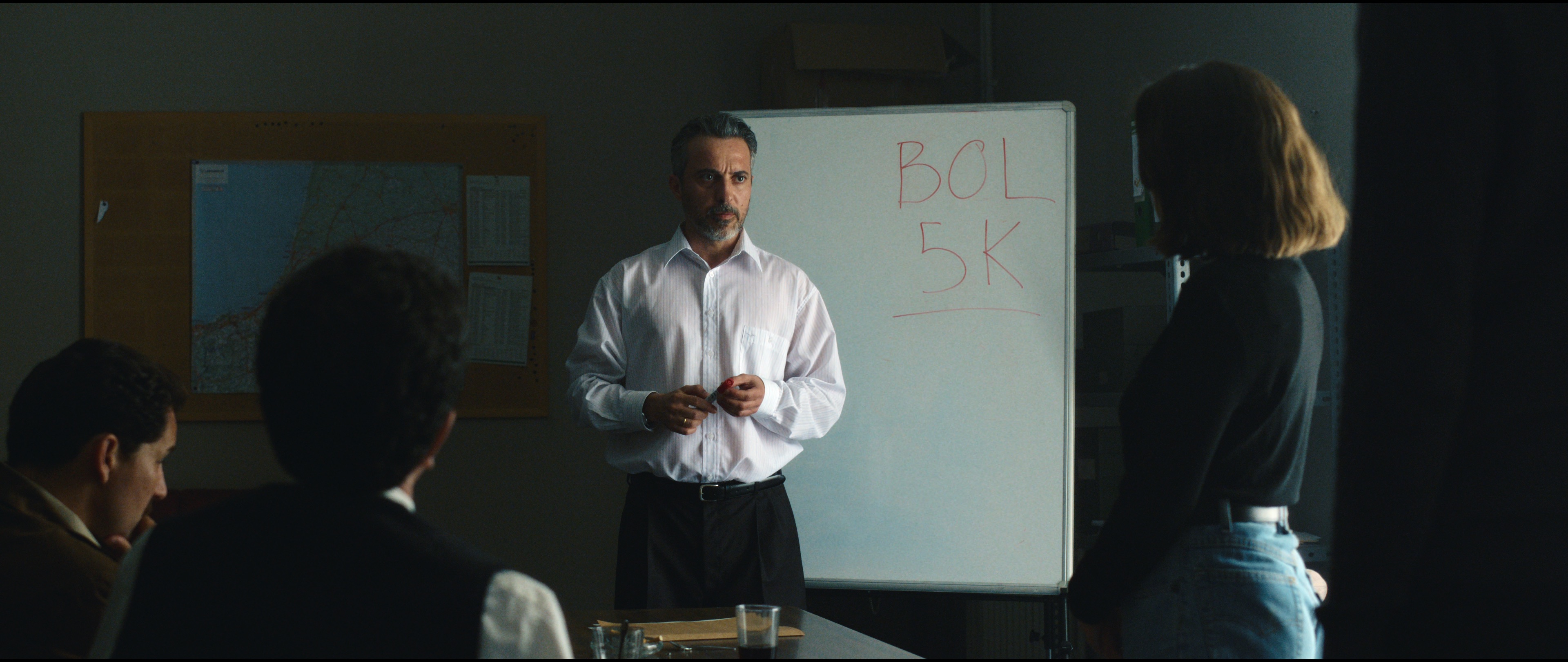Helmed by Agustín Díaz Yanes, Netflix’s ‘She Walks in Darkness’ follows Amaia, a young Spanish Civil Guard officer who has been living in southern France as an undercover agent within the ranks of ETA, the Basque Separatist Group, for a decade. Having gradually entered the deepest circles of the group, the protagonist uses everything within her power to accomplish her mission and uncover the terror organization’s guarded secrets. However, this double life, coupled with the horror she witnesses as an ETA member, begins to take its toll on Amaia. This spy thriller undertakes a deep exploration into how the lines between right and wrong become blurred as the paths of violence and justice merge, bearing consequences for the person in the crossroads. As the end of the mission comes closer, the events turn on their head once again, throwing Amaia into a life-and-death situation. SPOILERS AHEAD.
She Walks in Darkness Plot Synopsis
The movie begins with Amaia handing over the keys to two men in a car, who then head out to the street and assassinate a political figure in broad daylight. Amaia, a schoolteacher, is shocked by this development, and the subsequent spiral dials things back to nearly two years ago. We learn that her real identity is Amaya Mateos Gines, and that she is a Spanish Civil Guard officer turned into a spy. Her task is to infiltrate the ranks of the terrorist group known as ETA, whose ultimate aim is the separation of the Basque Country from Spain. Her primary target, to that end, becomes Begona Landaburu, an ETA leader who also runs a school, where Amaia finds employment. From there, the two gradually connect, and the protagonist becomes a part of the terrorist group tasked with bridging essential elements and strategies together. During this time, she routinely maintains communications with the police, exchanging information through garbage bags.

As the covert operation deepens, Amaia finds herself more involved in ETA’s handiwork, which often leads to the deaths of several popular and political figures. Eager to make herself count, the protagonist scouts the group’s next target, a sergeant who is, in reality, handpicked and trained by the Civil Guard. In the failed attempt assassination that follows, Amaia is nearly defeated by the sergeant, and has to shoot him in the chest. While the man survives, the incident leaves her shaken and doubtful of her noble cause, prompting an early exit from the mission, as well as from ETA. This separation, however, is short-lived, as before long she finds herself drawn back to service. This time, the stakes are even higher, and with many members being arrested left and right, Amaiya and Begona are forced to flee to France, which has been the Civil Guard’s plan all along.

Once in France, Amaia takes on the role of driver, transporting one important member of ETA after another to increasingly secluded locations. She begins drawing mental maps of these occasions, figuring out the locations of many of the hideouts, as well as those of the members. However, the mounting losses force ETA to reconsider the possibility that there is a mole in disguise. Before things reach back to Amaiya, a different mole, working for the Secret Service, is discovered and given a brutal death right in front of her. However, this does not stop Amaia from continuing her courageous dives into ETA’s secrets, which leads her to the exact coordinates of ETA’s biggest hideout cell, named Txernobel. This, coupled with the arrest of several big names, leads to the collective realization for the group that there are still enemies within, and as such, the clock is ticking for Amaia.
She Walks in Darkness Ending: Is Amaia Caught by ETA? Does She Survive?
In the final sequence of ‘She Walks in Darkness,’ Amaia comes within inches of being caught as the mole who has been creating problems for ETA all along. Following a lengthened investigation into her own ranks, Anboto discovers that the protagonist, who works as the terrorist group’s driver, has been feeding information to the Spanish Civil Guard. This revelation requires immediate action, and Anboto sends in one of her mercenaries to finish the job under the guise of a new driving task. However, what saves Amaia’s life in this near-fatal scenario is the predetermined system of warning codes that was devised by Colonel Sanchez, her boss and handler. In a prior scene, he explained that the Italian song called “Parole Parole” would be played at the end of the morning radio show if Amaia’s cover was blown. When the moment of truth comes, Sanchez jumps the gun and plays the song in the middle of the radio show instead, causing a communication gap. Thinking on his feet, he follows that up with the song’s French rendition being played on a local radio, alerting Amaia.

The arrival of the mercenary coincides with Amaia hearing the song and realizing the grimness of her situation. To that end, her options get steadily limited, compelling her to escape the house in secret and make a mad dash for the forest. By the time her opponent catches wind of this, it is already too late. As Amaia races through the thick green cover, the song helps in stitching together several other scenes, converting the sequence into a recollection of everything the protagonist has endured. After an exhausting run that pushes Amaia to the limit, she finally catches the road once again and pauses to catch her breath. The distance established between her and ETA, coupled with their limited means of transportation, points to Amaia now being free, with the possibility of her returning to Spain becoming more and more believable.

While Colonel Sanchez promises to bring Amaia in, the uncertainty of his future position in the Civil Guard makes the protagonist’s trajectory more ambiguous. It is likely that she makes it to the border and gets the help of the Spanish and French police, potentially alerting them about more of the secrets that ETA holds within itself. With her return imminent, Amaia is bound to return to her perennial questions of identity, this time with a haunting past attached to them. In an earlier scene, she reveals her lingering loneliness and how she yearns to forge new friendships and rekindle old bonds. While the end of her covert operation comes with a chance to do all that, the emotional and psychological baggage that follows makes things all the more tricky. Whether Amaia continues to be a part of the Civil Guard or questions the harsh methods that they often employ depends entirely on the transformations she has endured over the years.
Does the ETA Fall? Are Anboto and Dagoki Arrested?
The fact that Amaia likely makes it out of their grasp alive comes as one of many devastating blows to ETA, signaling their imminent fall. In the informational cards that follow the final scene, we learn that the covert mission, called “Operation Mayhem,” played a pivotal role in bringing many of the terrorist organization’s weaknesses to light. In particular, her intel about the locations of ETA hideouts strips the group of much of its offensive prowess. This weakening process is accelerated with the arrest of several top-level planners and executives within ETA. The consequent blow to their numbers and logistics becomes a game-changing factor in their eventual fall, with the informational cards confirming this to be the case. Although we are not shown the exact moment that ETA collapses or is defeated by the police forces, the established trajectory supports the idea.

ETA’s impending defeat is exemplified by the arrest of Anboto and Dagoki, two of the leaders and the primary thinkers of the terrorist group, who are captured in swift succession. The sequence plays right alongside Amaia’s escape run, narratively binding the two events. Earlier in the movie, Sanchez reveals his plans to intercept Anboto’s house sooner or later, and the effort to save the protagonist’s life likely plays a part in this quick mission. With the brains of ETA now behind bars, the group is left imbalanced, and those inner disturbances lead to more external strife, not just in the Basque Country but in many parts of Europe and beyond. However, Anboto’s arrest also has a microscopic dimension, as it disrupts the entire case that the terrorist leader had built up against Amaia. Believing her to be too perfect, Anboto consistently kept her eye on the protagonist, but with the former’s arrest, that twisted dynamic reaches an off-screen conclusion.
What Happens to Colonel Sanchez? Is He Tried For Torture?
While Colonel Sanchez paved the way for Amaia’s work as a pole and as a covert operative, his own awareness of churning out information is put into question. In particular, an occasion from his past makes headlines once again, as Sanchez learns that he is being tried for torture and abuse. At earlier points in the film, it is shown that Sanchez’s vast knowledge about the insides of ETA comes as a result of him nabbing one of its foremost leaders, Joseba Landaburu. His wife later confirms that the torture inflicted upon him was the potential reason behind his eventual suicide. As such, the charges against Sanchez bring the story full circle, giving a balanced criticism of the display of inhumane acts across the board. However, following this revelation, we do not get a second glimpse into Sanchez’s internal life and struggles, making his fate ambiguous on some level.

Since the movie ends with Sanchez reining in some of ETA’s most important members and hideouts, there is a distinct possibility that the charges against him are dropped in the face of his accomplishments. However, given that it goes against the narrative principles of the movie, such a conclusion is unlikely. Instead, it makes more sense for the terrorists’ arrest to be a moment of closure for the colonel, setting up his trial for torture as the consequences of the twisted steps undertaken. What makes the situation more complex is his undeniable love for his nation, but that does not justify or excuse the horrific acts of violence he performs on captives like Joseba to churn out information. As such, the colonel’s conclusion stands as a moment of reflection that applies to the broader story, including Amaia’s decisions.
Read More: Monster in the Family: True Story of Stacey Kananen, Explained


